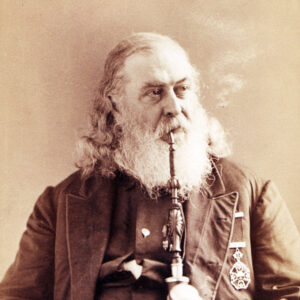calsfoundation@cals.org
Morals and Dogma of the Ancient and Accepted Scottish Rite of Freemasonry
First published in 1871, Morals and Dogma of the Ancient and Accepted Scottish Rite of Freemasonry is an abstruse philosophical tract written by Arkansas historical figure Albert Pike. The lengthy text explores the strengths and weaknesses of human character, the morals and meanings behind mythological symbols, major world religions, and ancient mystery teachings. It advocates for self-improvement through study and reflection, and it proclaims upright character to be a necessary support for democracy. Written as a spiritual instruction manual for the Masonic order, Morals and Dogma represents the philosophy of Scottish Rite Freemasonry as understood by Pike, who is known as the leading figure of the American Masonic revival movement of the mid-nineteenth century. Given Pike’s presence in Arkansas in the mid-1860s, it is possible that portions of Morals and Dogma were penned either at his residence and library in Little Rock (Pulaski County), or at a primitive Ouachita Mountain cabin, where Pike spent the final two years of the Civil War.
The text of Pike’s Morals and Dogma is arranged in thirty-two chapters of markedly unequal length, each of which is named for a stage of training in Scottish Rite Freemasonry, termed a degree. The names of the degrees evoke two primary metaphors: that of architectural builders of a divine or ideal temple on one hand, and that of chivalric heroes on the other. For example, the Eighth and Twelfth Degrees are named “Intendant of the Building,” and “Grand Master Architect,” clear references to the construction metaphor, while the Fifteenth and Twenty-Seventh Degrees are named “Knight of the East and West,” and “Knight Commander of the Temple,” the first clearly invoking the chivalric theme, with the second invoking both the chivalric and architectural metaphors.
Written as a companion to the rituals of the Scottish Rite Masonry popular in America in the nineteenth century, Morals and Dogma has as its central subject matter the ancient myths and related rites of the classical Mediterranean world and eastward. These ancient myths include the Egyptian Osiris story, the Greek Dionysos or Bacchus legend, the Greek Demeter and Persephone (or the equivalent Roman Ceres and Proserpina) myth, the Greek Apollo or Sun God myth, the Roman Mithraic mysteries, and many others drawn from the national spiritual traditions of Persia, Syria, Chaldea, Judaea, India, and China.
Pike casts these stories as analogies for the solar declination cycle, the annual increase and decrease of sunlight caused by the orbit of the Earth around the sun and the angle of inclination of the Earth’s axis. Pike presents the solar declination cycle as an embodiment of the struggle between good and evil, with the decrease of light connoting the nefarious and the increase of light connoting the righteous. Accordingly, heroic figures such as Osiris, Dionysos, Adonis, Mithras, Persephone, and even Jesus Christ are for Pike personifications of the light of the sun, the power of which diminishes sharply in the final weeks before winter solstice, only to be dramatically “reborn” near the end of December with the winter solstice.
In Morals and Dogma, Pike holds that this annual fluctuation in the reception of light is a pattern from which wisdom is to be extracted. Pike calls upon the mythic traditions of many lands and hails their sacred rites as initiations into this special wisdom, which he says will liberate the soul. Knowledge and initiations such as this, Pike claims in Morals and Dogma, functioned as a cohesive force in the classical world and therefore deserve to be revived and revered within the Masonic tradition, which he saw as the modern vehicle for the teachings of these related spiritual streams.
The thirty-two degrees described throughout the text in Morals and Dogma represent an entire sequence of moral and intellectual development within Ancient and Accepted Scottish Rite Freemasonry, named for its historic origins in sixteenth-century Scotland. Within this structure, Pike discusses themes drawn from the myths and mysteries of initiation from ancient Chaldea, Judaea, Egypt, Persia, and Greece, as well as from the Mithraic Mysteries of the late Roman Empire, the Gnostic mysticism of the early Christian period, the medieval Order of the Knights Templar, and the Renaissance Hermetic movement. Pike employs this mythic content to describe the fundamental ethical challenges of human living and to point out what he considered to be the path toward a moral high ground.
In recent years, Albert Pike and his Masonic writings have engendered controversy on the basis of his affiliation with the Confederate States of America during the Civil War, during which he served as brigadier general for the Confederacy. Pike has been characterized by some as a white supremacist, and by others as an inveterate literary borrower for his imitation of British poets and for his lengthy quotation of the nineteenth-century French writer Eliphas Levi. Pike’s scholarship nonetheless remains an important source for understanding the Masonic tradition.
For additional information:
Bullock, Steven C. Revolutionary Brotherhood: Freemasonry and the Transformation of the American Social Order, 1730–1840. Chapel Hill: University of North Carolina Press, 1996.
Cioffi, Chris. “Toppled, Warehoused, Waiting: Confederate Statue Still in Limbo in D.C.” Roll Call, November 18, 2020. https://rollcall.com/2020/11/18/locked-in-storage-confederate-statue-albert-pike/ (accessed June 30, 2022).
Hubbell, Jay B. The South in American Literature, 1607–1900. Durham, NC: Duke University Press, 1973.
Pike, Albert. Morals and Dogma of the Ancient and Accepted. Scottish Rite of Freemasonry. Charleston: Supreme Council of the Thirty-Third Degree for the Southern Jurisdiction of the United States, 1871.
Riley, Susan. “Albert Pike as an American Don Juan.” Arkansas Historical Quarterly 19 (Autumn 1960): 207–224.
Shepherd, William. The Seven Honor Men of Arkansas Scottish Rite Masonry. Conway, AR: River Road Press, 1978.
Stevenson, David. The First Freemasons: Scotland’s Early Lodges and Their Members. Aberdeen: Aberdeen University Press, 1988.
———. The Origins of Freemasonry: Scotland’s Century, 1590–1710. Cambridge: Cambridge University Press, 1988.
Uzzel, Robert Lesley. “The Kabbalistic Thought of Eliphas Levi and Its Influence in America.” PhD diss., Baylor University, 1995.
Ward, J. S. M. Freemasonry and the Ancient Gods. London: Simpkin, Marshall, Hamilton, Kent and Company, Ltd., 1921.
Maureen Richmond
Arkansas State University
 Civil War through Reconstruction, 1861 through 1874
Civil War through Reconstruction, 1861 through 1874 Literature and Authors
Literature and Authors Albert Pike
Albert Pike 




Comments
No comments on this entry yet.